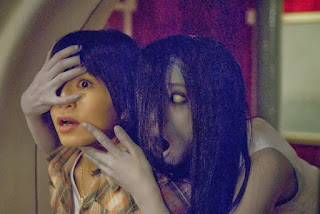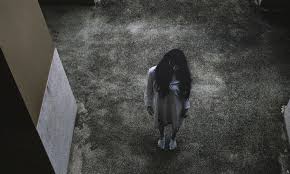The Kuchisake-onna
口裂け女
The Slit-Mouthed Woman
Japan is rife with stories of yokai; loosely what Westerners may refer to as demons, goblins, ghosts, and ghouls, that have persisted from the Edo period until the modern day in part thanks to anime, manga, and toys turning folklore figures into consumable, often cutesy, pop-culture darlings that are market friendly.
One of the most modern additions to the yokai "family" is the Kuchisake-onna, or The Split Mouth Woman. Here she is seen reimagined in a popular anime as a demon-figure that needs to be battled, far away from her usual, urban haunt, and extremely different from her usually human form.
Some folklorist claim that her origins date back to the Heian period of Japan, while others place it in the Edo period, and some say it didn't emerge until the 1970s.
In most Japanese versions of the tale, she is a woman who had been murdered--some tales say that she was disfigured by her Samurai husband for infidelity, and she died soon after the incident--that came back as a vengeful spirit. Her defining feature is her mouth which has been carved wide open from ear to ear. This, she hides underneath a surgical mask, a sight which isn't rare to see in Japan, especially during cold and flu seasons.
The story goes that she will approach you on the street when you are alone at night, and ask if she is pretty. If you say no, she will kill you immediately. If you say yes, she will take of her mask and ask "Even like this?" If you say no, she will kill you immediately. If you say yes--here the legends vary--she will either carve your face to look like hers, or perhaps let you go only to follow you home later and kill you then.
How you escape varies from teller to teller--many insist that you have to tell her she is average, which will confuse her so much you will have time to get away. Some say you have to say pomeade three times, which will also supposedly give you time to get away, and some say you have to throw her candy.
Some legends also claim that she targets only children, some seem to have men as her typical prey, some make no distinction.
Recently the legend has jumped the sea, and made its way to South Korea in the 2000s, where she has become known as the "surgical mask ghost." In Korea, she is more likely to be found in areas where plastic surgery is done, and a botched surgery is offered up as the cause of her disfigurement. Likewise, Korean tales differ on how you might escape--many saying the only way to do so is to run away without engaging with her at all.
What does it mean that we have a female ghost so focused on beauty? And what does it mean that no response is satisfactory enough to satisfy her? What does the difference between the ghost's disfigurement-- jealous husband vrs. botched plastic surgery--say about the different cultures this tale has grown popular in?



Comments
Post a Comment